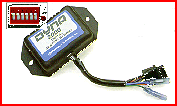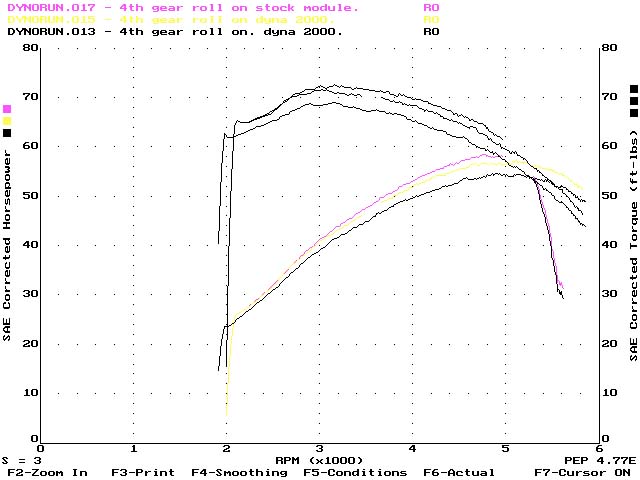Ignition Modules Dyna 2000 by DynaTek |
|
| Dyna 2000 Update: December, 1998 Dynatek has acknowledged that problems did exist in its early modules. Their engineering staff went to work on a new Dyna 2000 module with improved advance curves. As a result of this, it appears that the horsepower drops experienced in these tests are a thing of the past. Recent testing of the Dyna 2000 module by some of the more popular magazines in late 1998 seems to substantiate this claim. The Motorcycle Performance Guide staff will performed testing on a new DYNA 2000 module in April, 1999. We found that the new module generally performs as well as other modules. There should be little difference in the top end power between modules after properly setting the maximum advance. The horsepower achieved on an engine making 94 HP with a Screamin Eagle 8000 RPM race module was matched by the Dyna 2000. Since the testing was performed on a engine being set up for Drag Racing, little attention was paid to power under 3000 RPMs. Motorcycle Performance Guide can state with certainty that the Dyna 2000 ignition module is a reasonable choice for street performance applications. Screamin Eagle Adjustable Curve Ignition ModuleThe new Screamin Eagle adjustable Curve Ignition Module is the Dyna 2000. |
|
Performance and
Technical information on ignition modules for Harley-Davidson motorcycles.Dyna 2000 Ignition Module
The Dyna 2000 has been a highly recommended ignition module for late model Evolution motors for the past several years. Installation requires you remove the original HD unit and replace it with the Dyna 2000 module. Setup requires setting switches on the unit to select the advance curve, the rev limit, the pickup type and if the coil is single or dual fire. Bike Tech recommends the advance curve be set to 1 ( the most aggressive curve), with a 6000 RPM limit. Most bikes will use the stock HD pickup type. The setting on the coil is dependent upon your coil. The timing is set on the Dyna 2000 by setting the number one cylinder to top dead center, then adjusting the pickup unit until an indicator light on the ignition module comes on. The process of installing and setting up a Dyna 2000 unit should take less than 2 hours. The ease of installation and ease of setup make the Dyna 2000 an attractive unit to use. DYNATEK recommends the use of DYNA ignition wires with its ignition systems. Bike Tech has experienced problems by not using DYNA wires. We suggest you spend the few extra dollars it costs to get the Dyna ignition wires if you use the Dyna 2000 ignition. Installation of the Dyna 2000 on a 1997 FLSTF yielded some rather startling data. The subject bike was basically a stock bike with a ThunderSlide Kit installed, a Uni-Flow air filter and a set of Cycle Shack slip on mufflers on the stock header pipes. As testing began, timing was checked to ensure it was correct and a baseline dyno pull was made to compare to the results with the new ignition module installed. The base run yielded 59HP and 74 ft.lb. torque. The stock HD module was then replaced with a Dyna 2000 module. The settings were advance curve 1, 6000 RPM limit, stock pickup and dual fire. A second pull was made to compare the results. Much to our amazement, the maximum power went down. Testing continued on all 4 advance curves. Curves 1 and 2 provided virtually identical results of 57 HP and 72 ft. lb. torque. On curves 3 and 4, HP dropped to 54 and 69 ft. lb. torque. The test results below clearly show the results. The stock curves show the 5250 RPM limit cutoff. The Dyna 2000 runs show HP curves pulling to 5800 RPM. The results of the test are clear, the Dyna 2000 module hurt the performance of a 1997 bike. Bike Tech is aware of similar drops in horse power when installing a Dyna ignition on a late model sport bike. Dyna Tech seems to have some problems in delivering improved performance over stock ignition systems for late model bikes. Dyna's track record in the past has been excellent. Bike Tech can only assume that the problems noted will be fixed in the future. In the mean time, "let the buyer beware".
Bike Tech does have a theory of what may be happening. There is some circumstantial evidence that Harley-Davidson changed the advance curves of 1997 ignition modules. This information may be collaborated by the fact that HD released a new series of Screaming Eagle 6000 RPM ignition modules that are California Air Research Board (C.A.R.B.) approved. Harley-Davidson's need to meet Federal EPA regulations and the stricter California standards for its motorcycles and parts tend to indicate that HD could provide a module with the stock 5200 RPM limit (as provided in the past) and capture some of the after-market with a new 6000 RPM Screamin' Eagle module. If the advance curves are the same, no additional testing would have been required for the C.A.R.B. approval. HD's research into performance have yielded a wide variety of Screamin' Eagle parts. Many of these high performance parts perform better than or equal to any of the after market parts available. It would not be unreasonable to think that Harley-Davidson has managed to kill several birds with a single stone. A better performing stock ignition, an aftermarket ignition module and EPA/C.A.R.B. approval for both products. For other 1995 and older bikes, the Dyna 2000 is expected to provide improved results. Bike Tech's testing of a Dyna 2000 on a 1994 engine yielded better results. This bike did experience increased mid-range power over the stock ignition. It must be noted that the Dyna 2000 did not yield a higher maximum horse power figure than the stock module. This is to be expected since maximum advance on both ignitions was the same. The more aggressive advance curve of the Dyna 2000 provided the extra power in the low to mid-range (1500 to 2000 RPM). . |


